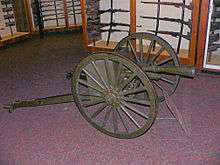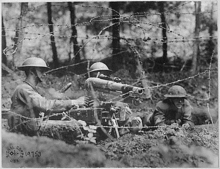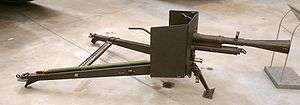Canon d'Infanterie de 37 modèle 1916 TRP
| Canon d'Infanterie de 37 modèle 1916 TRP | |
|---|---|
|
A 37 mm Infantry gun in the Brussels Army Museum. | |
| Type |
Infantry support gun Aircraft artillery |
| Place of origin |
|
| Service history | |
| Used by |
France United States Commonwealth of the Philippines Italy Poland |
| Wars |
World War I World War II |
| Production history | |
| Designer | Atelier de Puteaux |
| Produced | 1916 |
| Specifications | |
| Weight |
Combat: 108 kg (238 lbs) Travel: 160.5 kg (354 lbs) |
| Barrel length | 74 cm (2 ft 5 in) |
|
| |
| Caliber | 37x94R mm (1.45 in) |
| Elevation | -8° to 17° |
| Traverse | 35° |
| Rate of fire | Sustained: 25 rpm |
| Muzzle velocity | 367 m/s (1,200 ft/s)[1] |
| Effective firing range | 1,500 m (1,600 yd) |
| Maximum firing range | 2,400 m (2,600 yd) |
The Canon d'Infanterie de 37 modèle 1916 TRP (37mm mle.1916) was a French infantry support gun, first used during World War I. TRP stands for tir rapide, Puteaux (fast-firing, designed by the Atelier de Puteaux). The tactical purpose of this gun was the destruction of machine gun nests. It was also used on aircraft such as the Beardmore W.B.V and the Salmson-Moineau. Fighter ace René Fonck used a 37mm mle.1916 on a SPAD S.XII.
Description

For transport, this weapon could be broken down into 3 sections. In addition, wheels could be attached for towing. These guns were sometimes equipped with an armoured shield. They were all equipped with a removable APX telescopic sight.
U.S. high explosive ammunition for the TRP was the Mark II HE shell with a projectile weighing 0.67 Kilograms and a TNT bursting charge of 27.2 grams.[2] The French Army used the Obus explosif Mle1916 HE round with a projectile weighing 0.555 Kilograms and a bursting charge of 30 grams. Captured rounds of this type were designated Sprgr 147(f) by the German military in World War II.
History

During the First World War, the U.S. acquired a number of these guns, which they designated 37mm M1916. During the interwar years the US Army adopted a .22 caliber device to train with the 37mm cannon as an economic measure that allowed training on indoor ranges.[3] By 1941 the U.S. Army had put most of these into storage, scrapped them, or converted them for use as subcaliber devices for heavy guns. Some were used in the Philippines Campaign in 1941-42 due to shortages of the 37mm M3. The Japanese Type 11 was based on this design.
The French Army still had the cannon in service in 1940 as a substitute for the 25 mm Hotchkiss anti-tank gun, which was in short supply. After the defeat of France by Germany, the Wehrmacht began using the TRP under the designation 3.7 cm IG 152(f).
See also
| Wikimedia Commons has media related to Canon d'Infanterie de 37 modèle 1916 TRP. |
- List of U.S. Army weapons by supply catalog designation SNL A-7
- Infantry support gun
- List of infantry guns
- List of aircraft artillery
References

- ↑ Johnson, Melvin M., Jr. (1944). Rifles and Machine Guns. William Morrow and Company. p. 385.
- ↑ OrData record on Mk II HE shell
- ↑ "Army Target Practice Now Use Tiny Rifles." Popular Science, November 1930, P. 73.
- TM 9-2005 volume 3 Ordnance Materiel-General dated 1942
- FM 23-75
- TM 9-2300 standard artillery and fire control material. dated 1944
- SNL A-7
- SNL C-33
External links
- (1918) War Department Document No. 758 Provisional Instruction for the 37 Mm Gun Model 1916 R.F.
- 37-Millimeter Gun Matériel, Model of 1916. In "Handbook of artillery : including mobile, anti-aircraft and trench matériel". United States. Army. Ordnance Dept. May 1920
- www.landships.freeservers.com
